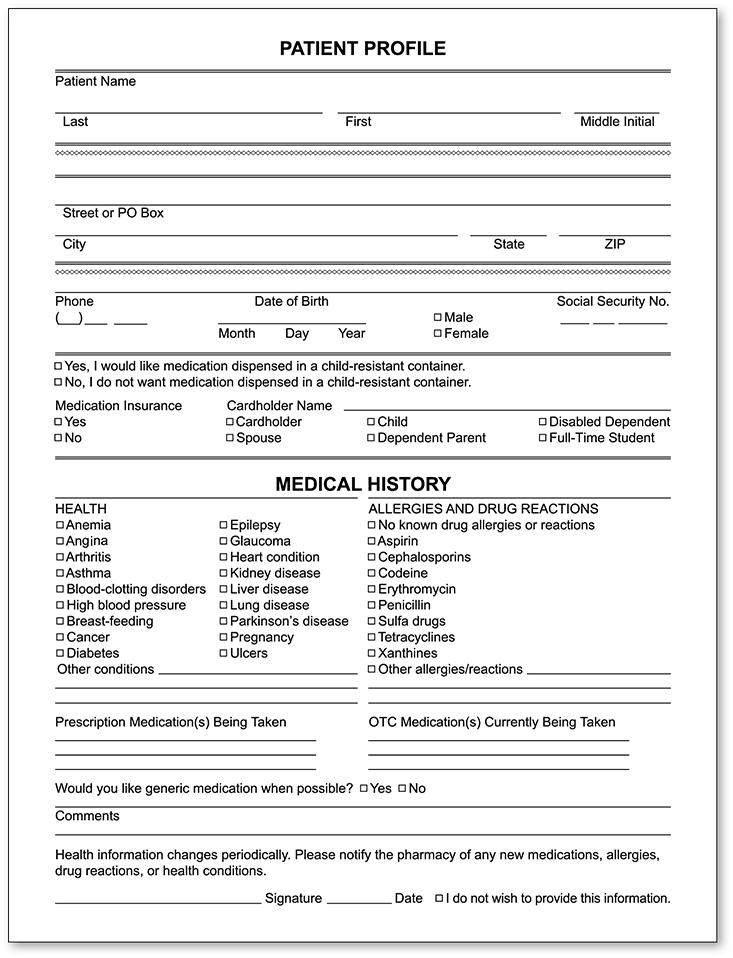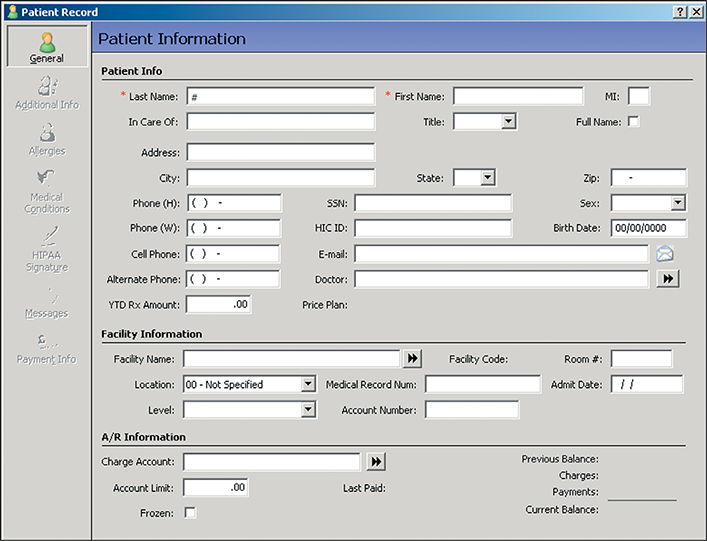7.5 Working with the Patient Profile Database
To process any prescription, a patient profile must be created or updated. The patient profile is the confidential data file in the pharmacy software that contains the customer’s demographic and insurance information. The profile lists all of the prescriptions that have been dispensed at that pharmacy for that individual by any prescriber.
Creating a New Patient Profile
When new customers come in with a prescription, the pharmacy technician needs to have them answer questions or have them complete a written patient profile questionnaire. Every pharmacy patient must have a current, updated profile to have a prescription filled. (See a sample profile form in Figure 7.7.) Components of the essential information include patient demographics (name, birth date, address, phone numbers, email address); insurance and billing information (covered in Chapters 8 and 9); medical, allergy, and prescription histories; and prescription preferences, such as no child-proof caps, large-print medication sheets, foreign language specifications, and so on. For an explanation of each of these components, see Table 7.5.
 Practice Tip
Practice Tip
It is helpful to ask patients if they have had prescriptions filled at other pharmacies and explain that this information is important for the safe dispensing of their new prescription.
It is also good if the patient questions and profile cover OTC drug and alcohol use, homeopathies, and dietary supplements (including vitamins and nutritional substances).
Table 7.5 Components of the Patient Profile
Component |
Content |
|---|---|
Identifying information |
Patient’s full name including middle initial in some cases, street address, telephone number, birth date, and sex (Increasingly, some programs are entering email addresses so that refill notifications and other communications can be made.) |
Insurance and billing information |
Information necessary for billing (More information on insurance billing is discussed in Chapter 8.) |
Medical and allergy history |
Information concerning existing conditions; for example, diabetes or heart disease, known allergies, and adverse drug reactions the patient has experienced (The pharmacy software reviews the medical history for the pharmacist to make sure that the prescription is safe to fill for a given patient.) |
Medication and prescription history |
Any prescriptions filled at this pharmacy location; some software includes OTC medications and supplements (The pharmacy software reviews this information for the pharmacist to make sure that the prescription will not cause adverse drug interactions [i.e., negative consequences] because of the combined effects of drugs and/or other drugs or foods.) |
Prescription preferences |
Patient preferences as they apply to prescriptions; for example, child-resistant or non–child-resistant containers, generic substitutions, large-print labels, foreign language preference, and so on |
HIPAA confidentiality |
Each new patient is required by law to receive and sign a statement of patient confidentiality, which is then documented and stored on the patient profile (This statement is for the protection of the pharmacy.) |
Figure 7.7 Written Patient Profile Form

Finally, it is important to know if the patient gets prescriptions filled at more than one pharmacy, as this makes the potential for drug interactions more possible. If so, the pharmacist may want to talk with the patient more before filling the prescription.
 Work Wise
Work Wise
Technicians need to make patients comfortable and encourage them to write down everything about their drug and supplement history.
HIPAA Requirements
In addition to completing the profile, the patient must also be given a copy of the pharmacy’s personal information privacy policies to comply with the Health Insurance Portability and Accountability Act (HIPAA). Patients have to sign off that they have received this notice, and proof is commonly scanned and saved in the computerized patient profile. If someone other than the patient is picking up the prescription, the signature on the HIPAA form may need to be deferred to a later date. It is extremely important that the confidentiality of patient medical information be maintained at all times. (For more information on patient confidentiality protocol, see Chapter 15.)
 Practice Tip
Practice Tip
For questions about HIPAA rules, go to the Frequently Asked Questions section of HIPAA at https://PharmPractice7e.ParadigmEducation.com/HIPAA.
Pharmacist Verification of New Profile
Once all the prescription information has been entered into the patient profile, it is verified by the pharmacist before or after the prescription is filled. The pharmacist will check that the correct date, patient, drug, dose, directions, refills, and prescriber were entered without typos or other errors.
Updating Current Customer Profile
If a patient profile already exists, the pharmacy technician finds the record and double-checks it, matching the patient name with the correct address. This step is critical, as more than one patient often has the same name (Bob Anderson) or a similar name (Michael versus Michelle Courier). Also, there may be more than one address listed in the patient profile. Patients may also be known by and entered under their middle name, for example as R. Karen Lee instead of the legal name of Roberta K. Lee.
Changed or hyphenated names can also be tricky. Those who have recently married or divorced may have a new last name, but only their earlier name may be recognized by an insurance company.
As a safeguard, a second patient identifier is usually used for verification just as with prescriptions. This identifier is commonly the date of birth (see Figure 7.8). Failure to verify the identifiers may result in a serious medication error—a prescription entered into the wrong patient profile and thus filled for the wrong patient.
Figure 7.8 Computerized Patient Profile Sample

The pharmacy technician also needs to verify that the name, address, and phone number of the prescriber have not changed and match the information in the patient profile. Many prescribers practice at more than one medical office. If an incorrect phone number is entered, refill requests will be faxed or telephoned to the wrong medical office.
The patient’s medication and prescription history section will contain the information on all the prescriptions filled by this pharmacy (and all the pharmacies of the same chain), including the drug names, prescription numbers (automatically assigned by the computer at each prescription filling), dosage forms, quantities, numbers of refills authorized (if any), prescriber’s name and identifiers, and patient cost or copayment for the prescriptions. Patients often have many different prescribers.
All new information entered must also be verified by the pharmacist.